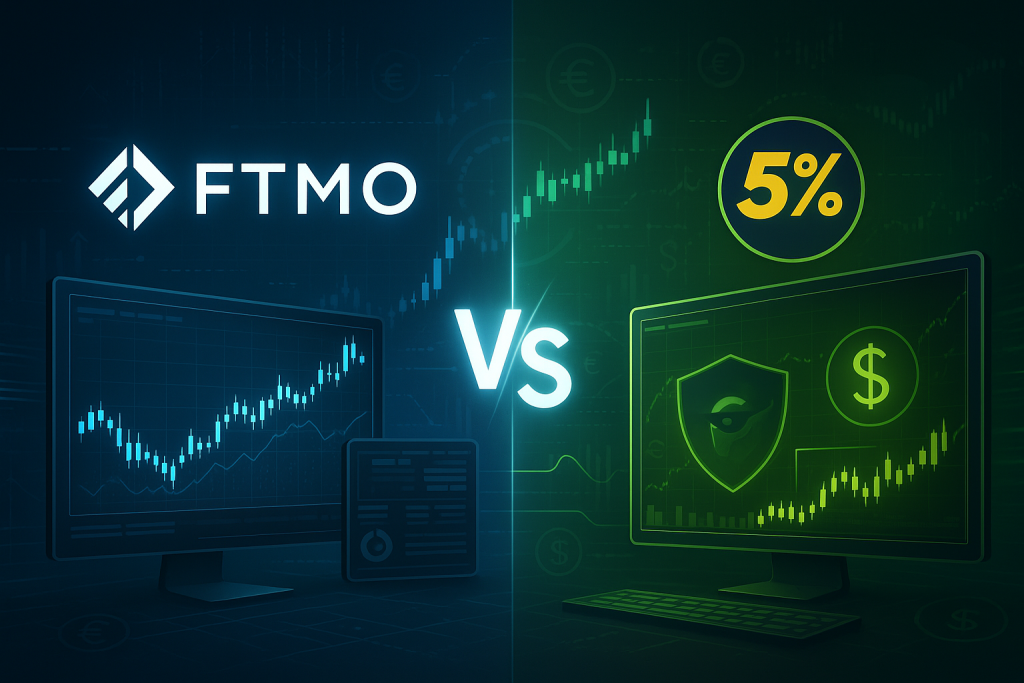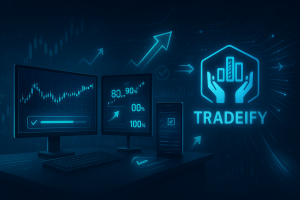Introduction
The world of forex prop trading is evolving rapidly, with more traders turning to funded accounts to grow their income and career. But not all prop firms are created equal—especially when it comes to scaling capital, profit share progression, risk rules, and payout flexibility. Among the many firms out there, FTMO and The5ers are two of the most established and widely discussed names in the industry. But while they’re both popular, their models are very different—and those differences could directly impact your growth as a trader.
Here’s a basic side‑by‑side view:
| Feature | FTMO | The5ers |
| Growth / scaling | Grow slowly over time when your results are steady | Jump levels by hitting profit goals |
| Profit share | You start with ~80%, then move toward ~90% | You may start lower (50%) but can reach 100% in top tiers |
| Rules / risk | Uses daily and total drawdowns strictly | Rules are stricter early, more flexible later |
| Payouts / withdrawals | Every 14 days if all conditions met | Also bi‑weekly, but resets when you level up |
| Platform & costs | Many platform options, known entry fees | Mainly MT5, varied program fees, possible extra costs |
Let’s first look at what makes these firms stand out individually.
FTMO, based in the Czech Republic, has built its reputation on providing traders with a highly structured and disciplined environment. Known for its two-phase evaluation process (Challenge and Verification), FTMO tests traders on their consistency, risk control, and profitability before granting them access to funded accounts. Once funded, traders receive a base profit share of 80%, which can scale up to 90% through the firm’s built-in scaling plan. FTMO also offers traders a selection of robust platforms like MT4, MT5, cTrader, and DXTrader, giving them the flexibility to execute strategies their way. Its transparent pricing, stable rules, and a clear path to scale capital up to $2 million make it a favorite among disciplined swing and intraday traders who value predictability.
The5ers, headquartered in Israel, takes a different approach. It promotes a milestone-based growth model that allows traders to jump through levels by meeting profit targets—not time cycles. This model can suit aggressive and high-performing traders who want to rapidly scale their capital and unlock better profit splits. In many programs, traders start with a 50% profit split, but that can rise to 75%, 80%, or even 100% at the highest tiers. The5ers emphasizes flexibility in trading styles across many of its programs—such as allowing overnight or weekend trades—and its platform is based primarily on MetaTrader 5 (MT5). With the potential to manage up to $4 million in capital, The5ers positions itself as a more dynamic, performance-driven firm with a focus on long-term trader development.
So how do they compare head-to-head on the points that matter most to real traders—like how much you can grow, how much you keep, how strict the rules are, and how often you can withdraw? That’s what we’re about to break down in this in-depth comparison, to help you decide which firm truly supports your journey toward scalable and sustainable forex success.
Growth / Scaling (How Big You Can Get)
When you’re funded, your path forward is defined by how the prop firm lets you expand the capital you trade with. That is scaling. The differences between FTMO and The5ers in this area can seriously affect how fast and how far you grow.
With FTMO, scaling is structured and time‑based. Once you have a funded account, there is a “Scaling Plan”: every four months (a cycle) you can apply for a 25% capital increase if you meet specific performance criteria. You need to earn at least 10% net profit over the four‑month period, make at least two withdrawals, and maintain a positive account balance at the moment of scaling. If you do, FTMO will boost your capital and also upgrade your profit share to around 90%. Over time, you can scale up to as high as USD 2,000,000 with FTMO’s scaling plan.
Because of this design, FTMO rewards steady, consistent performance over time. It’s not about a single big winning month—it’s about proving you can maintain discipline over several cycles. One downside: the growth is gradual. For instance, going from $100,000 to very high tiers may require multiple cycles with good performance each time.
Also, FTMO imposes a maximum capital allocation per trader or strategy before scaling: you typically can’t hold more than USD 400,000 in active FTMO accounts (before scaling). If you hit that, you have to scale or merge accounts to grow further.
In contrast, The5ers uses a level / milestone approach. Instead of time‑based cycles, you ascend levels by meeting profit targets in your funded account. Each level typically comes with increased trading capital, improved profit share, and relaxed rules. For example, The5ers markets that you can manage up to USD 4,000,000 in their higher levels.
One advantage of The5ers’ model is flexibility. If you have a streak of strong performance, you can move quickly through levels. You are less constrained by time windows. If your style is aggressive and high‑return, The5ers may reward that more dynamically. However, early levels usually come with tighter rules, and reaching upper levels can be challenging for many traders.
Here’s a comparison table of how scaling works:
| Scaling Feature | FTMO | The5ers |
| Growth method | Time‑based cycle approach (every 4 months) | Milestone / profit target based |
| Required performance | 10% net profit in cycle, ≥ 2 withdrawals, positive balance | Meet specific profit goals per level |
| Capital increase size | +25% per successful cycle | Variable jumps as you level up |
| Maximum scaling limit | Up to USD 2,000,000 (via scaling) | Up to USD 4,000,000 in some programs |
| Speed of growth | Slower but steady | Potentially faster if you perform well |
| Risk of stalled growth | Yes—if one cycle fails, scaling pauses | Yes—if you fail to hit a milestone, you remain at current level |
Because of these differences, your choice should depend on whether you prefer structured, steady growth or potentially faster jumps (with higher risk).
Profit Share / What You Keep
A tempting headline might say “You keep 90%,” but what you actually take home depends on many conditions. The baseline share, how it upgrades, and under what conditions it can fall all matter greatly.
FTMO’s usual base profit share is 80% to the trader and 20% to FTMO. When you scale your account under FTMO’s Scaling Plan, your split can increase to 90% of profits. An important detail: the upgraded split (90%) applies to newly scaled accounts, not to merged accounts combining scaled and non‑scaled ones. Also, if you merge accounts, the profit split may revert to 80%. So, your share progression depends not just on your performance but on how you manage accounts and scaling.
Another point: when you’re in the evaluation / challenge phases, you usually don’t keep profits (these phases are simulated). The profit share only comes into play once you are funded.
On the The5ers side, many of their programs start with a 50 / 50 split (you keep half) in the earlier levels. As you progress through levels, your share improves, potentially up to 75%, 80%, or even 100% in top levels. Some marketing claims even say “profit share between 80% and 100%,” depending on the level.
Your effective take depends on how fast and how reliably you advance levels. If it takes many months to get from level 1 to high levels, much of your revenue over that time will come under lower splits. Also, a poor performance or rule violation might block your path upward.
Here’s a comparison:
| Profit Share Feature | FTMO | The5ers |
| Starting share | 80% | ~50% (in many programs) |
| Upgraded share | 90% (on scaled account) | Up to 100% in elite levels |
| Conditions to reach upgrade | Meeting cycle performance, withdrawals, positive balance | Reaching profit goals, passing milestones, staying within rules |
| Risk of share decline | Merging non-scaled with scaled may revert share | Falling behind or violating rules may block further upgrades |
| Impact of poor performance | May delay scaling / upgrade | Can delay or block level increases |
If your strategy is disciplined and consistent, FTMO gives you a relatively good share from the start and a clear path upward. The5ers, on the other hand, offers higher upside—but only for those who can reliably outperform through many levels.
Rules & Risk Controls (Staying Alive Matters)
Even if you have a great share and scaling path, breaking rules means you lose access. The stricter or more intricate the rules, the more careful you must be.
FTMO maintains several standard rules across all accounts: a daily loss limit and a maximum drawdown limit (total loss). In evaluation phases, you have to reach profit targets while not exceeding these drawdowns. Uniquely, FTMO does not impose a fixed time limit to complete the challenge or verification: as long as you meet the trading objectives, you can take your time (minimum 4 trading days). Because of that, you can trade carefully, not forced by a deadline.
After you are funded, FTMO continues to enforce strict rules. Violating the daily loss limit or max drawdown can lead to immediate termination of funding. Similarly, strategy restrictions (for example, news trading or holding overnight positions) may apply in some account types. Also, the scaling plan requires you to maintain these rules across cycles — if you breach in a period, your scaling may be delayed or disallowed.
One limitation: FTMO caps the active capital you can hold (before scaling) to USD 400,000 per trader/strategy. Exceeding that (e.g. by combining multiple accounts) is disallowed, and FTMO reserves the right to suspend accounts that violate this.
In the case of The5ers, rules vary by program and by level. Early levels tend to have tight drawdown constraints, limits on daily loss, and restrictions on trading strategies (e.g. scalping, hedging, or news trading). The5ers promotes that it allows any trading style and overnight / weekend holdings in many accounts (especially in higher levels) to give flexibility. Because levels change risk rules, you need to check the rules each time you level up. Some traders report that The5ers calculates drawdowns based on equity at end-of-day, which can be more forgiving of intraday swings.
Additionally, inactivity rules may apply in The5ers: if you don’t trade for a certain number of days, your account may expire or become inactive, depending on the program.
Here’s a comparison:
| Rule / Risk Feature | FTMO | The5ers |
| Loss limits | Daily + total drawdown strictly enforced | Tight early, more relaxed later |
| Time pressure | None (no fixed challenge deadline) | Many programs also avoid strict deadlines |
| Strategy restrictions | Some banned trades depending on account | Early-level restrictions; many allow diverse styles later |
| Drawdown calculation | Based on equity/realized P&L and continuous checks | Some report end-of-day equity method (less punishing intraday swings) |
| Inactivity / expiration | Less common | More likely, depending on the program |
| Consequence of violation | Account termination, scaling block | Penalty, disqualification, or reset to prior level |
If your trading style includes volatility, swings, and occasional intraday drawdowns, the more forgiving rules matter greatly. The5ers may give you more flexibility over time, but early levels can be punishing. FTMO’s consistency and clarity in rules is a strong appeal for many disciplined traders.
Payouts & Withdrawal Mechanics
Being able to withdraw your gains reliably—and often—is essential. All the profit in the world is useless if you can’t access it.
FTMO’s model pays you every 14 days (bi-weekly) after your account is funded and all conditions are met. Their typical processing time is fast (some sources claim around 8 hours in many cases) when all requirements are satisfied. When you scale during a payout, you request scale as part of that payout process. Once you take a withdrawal, your remaining capital becomes your new base for drawdowns and scaling in future periods. That adjustment is baked in, so your risk limits reset relative to your remaining balance. Because FTMO’s pay cycles are regular, traders can use predictable compounding.
The5ers also offers bi-weekly payouts once you are in the funded stage. They often require a minimum withdrawal amount (for example, many programs require at least USD 150) before you can cash out. If you level up (i.e. jump to next capital level), The5ers resets the payout cycle—meaning you might have to wait a full period for your next withdrawal. They also support multiple payout methods: bank transfer, crypto, internal “Hub credit,” or even a branded visa card (depending on your region and program).
Crucially, The5ers does not penalize you for withdrawing profits when it comes to your ability to scale; taking profits does not block future level upgrades. Because of this, many traders like the flexibility of extracting gains while continuing to pursue higher levels.
Here is a comparison:
| Withdrawal Feature | FTMO | The5ers |
| Frequency | Every 14 days | Every 14 days (bi-weekly) |
| Processing time | Some payouts processed quickly (e.g. 8 hours) | Varies by method, region, and program |
| Minimum withdrawal | Depends on plan | Many programs enforce ~$150 minimum |
| Reset on level / scale | Balance after withdrawal becomes new base | Cycle resets on upgrade / level change |
| Impact on scaling | Withdrawal does not block scaling | Withdrawal does not block scaling |
| Payment methods | Usually bank / local methods | Bank, crypto, internal credit, visa, etc. |
If you want to compound aggressively, frequent and reliable payouts are critical. FTMO’s model gives predictability; The5ers gives flexibility, especially for traders scaling up rapidly.
Platforms, Costs & Flexibility
This section is about how you will actually trade: the software, the costs you pay, and how stable or flexible the terms are.
FTMO supports MT4, MT5, cTrader, DXTrader — giving traders multiple options depending on their preferences. Their evaluation (challenge / verification) fees are fixed and transparent based on account size, with no hidden surprise costs during the challenge. Because the cost structure is stable and predictable, you know your risk up front. FTMO is also relatively stable in its rules and less prone to frequent surprise changes.
However, some traders report that FTMO’s spreads are not as tight as some competitor firms (i.e. execution may have slippage compared to ultra-low spread brokers). That gap can matter especially for high-frequency or scalping strategies.
The5ers, in contrast, primarily operates on MT5 (MetaTrader 5) as its core trading platform. Their program fees vary by the program you choose (Bootcamp, High Stakes, Hyper Growth). Some entry levels are inexpensive; higher levels or faster paths cost more. In some levels, additional costs may show up: commission, swap rates, or infrastructure fees (especially in advanced levels). Many users report that The5ers provides tight spreads and better execution, particularly in forex pairs, which can benefit active traders. One caution: because The5ers updates or changes rules/programs, you need to monitor terms regularly. Some programs have adjusted rules in lower levels or changed cost structures.
Here’s a comparison:
| Platform / Cost Feature | FTMO | The5ers |
| Platform options | MT4, MT5, cTrader, DXTrader | Primarily MT5 |
| Challenge / entry cost | Fixed and transparent | Varies by program |
| Hidden / extra fees | Low / rarely changing | Possible commission, infrastructure or swap costs |
| Spread tightness / execution | Stable, but sometimes wider spreads | Many users praise tight spreads |
| Rule / cost changes | More stable over time | More frequent updates, you must monitor |
If you like flexibility in platform and a stable cost structure, FTMO is strong. If your strategy requires ultra-tight spreads and you are okay managing changes, The5ers may give you the execution edge.
Conclusion
When comparing FTMO and The5ers, the “best” depends heavily on your trading style, consistency, and risk tolerance. There is no universal winner—only the better fit for you.
If you prefer stability, clear structure, and reliable progression, FTMO is appealing. You know your entry cost, your split is strong from the start, and the scaling path is methodical. That kind of predictable environment helps many disciplined traders avoid pitfalls. Even though the scaling is gradual, for many traders that steady growth is safer and more sustainable.
If you are confident in your ability to generate strong returns, want to scale aggressively, and don’t mind stricter early rules, The5ers offers higher upside. Its level‑based system lets big performers jump forward faster, and once you reach upper levels, your splits and capital can become very advantageous. The flexibility in withdrawal and strategy styles also appeals to traders who want freedom.
But here’s the kicker: all the splits, scaling perks, and rules are meaningless if your execution is poor. Latency, slippage, missed orders, or unstable connectivity will eat through your edge. That is why pairing your prop firm with an excellent TradingVPS is critical. A fast, stable VPS located close to broker servers can reduce slippage, reduce chance of disconnections, and ensure your orders land precisely when you need them.




